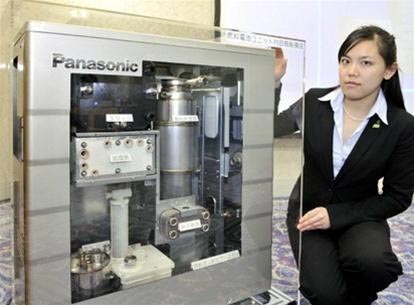Japan: Fuel cell 'crowned'
In the context of rising world oil prices every day, thousands of families in Japan are eagerly participating in an ambitious government experiment to use fuel cells to supply energy for projection. Bright and warm in households.
In 2005, the Prime Minister's office became the first place in the world to equip fuel cells that provide energy for daily life needs.
To date, about 3,000 households have signed an agreement to install fuel cell systems in their families, with the goal of making Japan a leader in clean energy use. 'a hydrogen society ', gradually eliminating the habit of using petroleum fuels to reduce greenhouse gas emissions.
The principle of energy batteries has been known since the end of the 14th century, but it was not until 1961 that it was first applied on American Gemini aircraft.
Fuel cells generate electricity and hot water through a chemical reaction between oxygen and hydrogen extracted from natural gas or other fuels. Hydrogen can be obtained from various sources such as hydrocarbons, natural gas, biomass or waste to make methane. Fuel cells do not emit carbon dioxide, but it also produces much less gas during hydrogen extraction. from natural gas, however, emissions are quite low compared to traditional forms of energy generation.

More and more families in Japan use fuel cells.
Another advantage of this system is that it can be used regardless of the power source cut off when natural disasters occur (Japan is in an area where earthquakes occur).
Japan is a resource-poor country, seeking to reduce its dependence on oil resources by independently developing high-efficiency home appliances and creating alternative energy sources.
Currently the Japanese government is calling for members of households to reduce bathing time to reduce energy consumption in order to achieve the goal set by the Kyoto decree to reduce the amount of carbon dioxide released by households. out. Currently in Japan there are about 48 million households and 25 million households living in individual households.
The Japanese government supported strong research companies such as Nippon Oil, Tokyo Gas, Sanyo Electric, Toshiba, Matsushita, Mitsubishi Heavy Industries and Toyota Motor. They predict that in the next few years, Japanese households can use about 550,000 fuel cells each year.
However, the price of these systems is still quite expensive, about 19,000 USD including installation fees. Companies are trying to reduce costs so that the system can reach more users.
Japanese automakers are also pursuing the dream of fuel cells, with the aim of creating cars that can generate energy through chemical reactions between hydrogen and oxygen and release water.
- Japan: Fuel Cell Train Test
- Fuel cell, alternative energy for hydropower
- Cheap fuel production by ALD method
- Singapore develops premium fuel cell materials
- Nissan produces fuel-cell vehicles for environmental protection
- Load only a drop of methanol
- Fuel cell chips were enlightened
- The phone works by urine
- Apple filed a patent for a laptop battery that runs weekly
- Experimental fuel cell reaches 10 hours
- The US and Japan will store nuclear waste in Mongolia
- Fuel cell for laptop is about to appear on the market
 Is the magnetic North Pole shift dangerous to humanity?
Is the magnetic North Pole shift dangerous to humanity? Washington legalizes the recycling of human bodies into fertilizer
Washington legalizes the recycling of human bodies into fertilizer Lightning stone - the mysterious guest
Lightning stone - the mysterious guest Stunned by the mysterious sunset, strange appearance
Stunned by the mysterious sunset, strange appearance The secret behind China's 'explosive carving' craft
The secret behind China's 'explosive carving' craft  Canada to build nuclear grave nearly 700m deep
Canada to build nuclear grave nearly 700m deep  Breakthrough technology enables rockets to use any metal as fuel
Breakthrough technology enables rockets to use any metal as fuel  Japan will use robots to remove melted fuel in Fukushima
Japan will use robots to remove melted fuel in Fukushima  The Swiss train set a record of running 2,803km on hydrogen
The Swiss train set a record of running 2,803km on hydrogen  Hydrogen trucks create a big explosion in the electric vehicle village: 500km, refueling takes 10 minutes
Hydrogen trucks create a big explosion in the electric vehicle village: 500km, refueling takes 10 minutes 